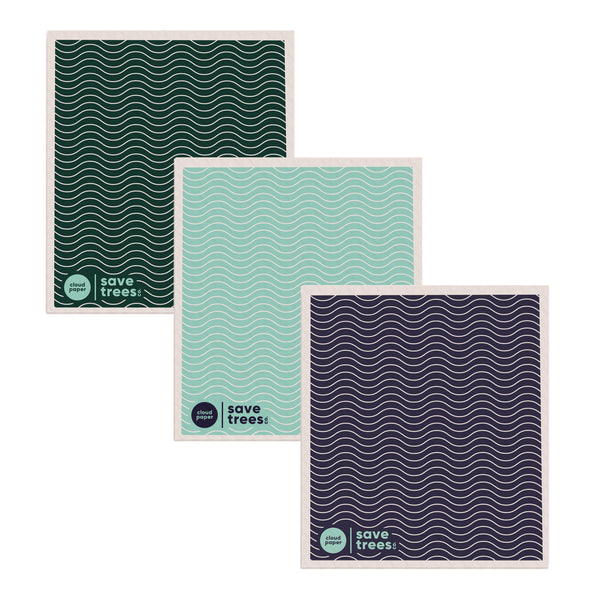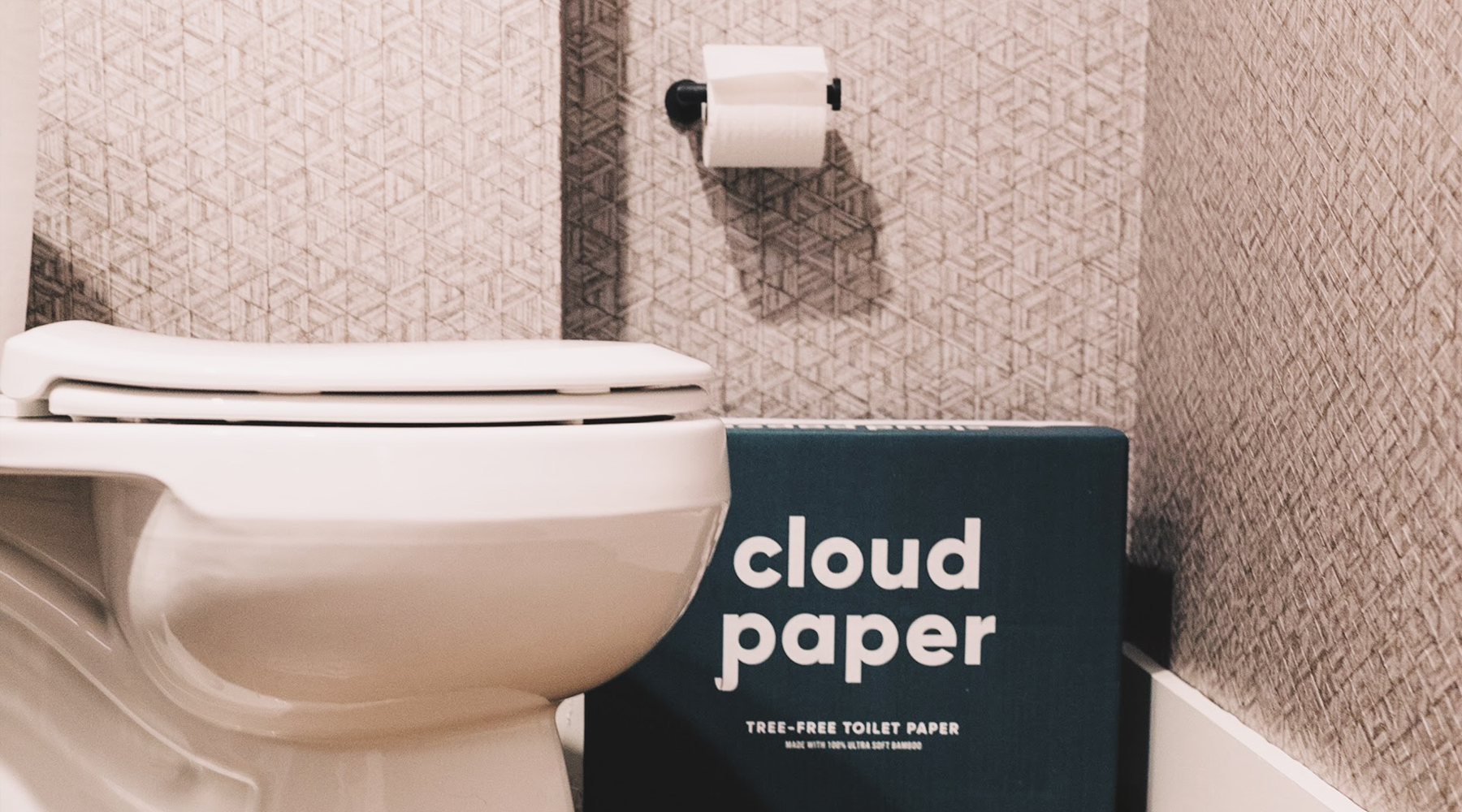Save even more trees and try...

Swish Cloth - Pack of Three
Frequency: Every 4 months

Bamboo Tissues - 12 Boxes
Frequency: Every 6 months

Navigating the world of environmentally-friendly toilet paper can be confusing at best, crazy-making at worst. There are so many questions that need to be answered.
What’s the most eco-friendly toilet paper? Is recycled toilet paper better than bamboo toilet paper? Can you even flush bamboo toilet paper? Which is softer — bamboo or recycled toilet paper?
And then there’s cost. Is a bamboo toilet paper subscription really more expensive? Comparing prices across the board doesn’t always give you the entire picture.
That’s why we decided to dig deep into eco-friendly toilet tissue options and lay it all out for you. We’re going to hash out the pros and cons of bamboo and recycled toilet paper — from carbon footprint to softness to cost to everything in between. And by the time we’re done, the winner will be clear. (Spoiler alert: it’s bamboo toilet paper for the win!)
So let’s close the lid on this toilet paper debate once and for all.
Toilet paper. It’s a basic household staple and yet we don’t think much about the tissue in our bathrooms from day to day (unless there’s a worldwide shortage). Of course, humans haven’t always used toilet paper to do our business.
We have American inventor Joseph Gayetty to thank for the everyday bathroom staple. Way back in 1857 he created flat sheets of paper coated in aloe and called it “therapeutic paper.” The product flopped. But ten years later three brothers hit on the right blend of marketing and the Scott Paper Company made toilet paper mainstream.
The toilet-paper making process hasn’t changed much since Gayetty’s time. It was made from trees then, and it's made from trees today. Let’s take a quick look at how it’s done, and why better, more eco-friendly options are needed.

Conventional toilet paper starts with a mix of 70% hardwood and 30% softwood trees. Many of these trees come from Canada's boreal forest, a carbon-dense old growth forest that spans a billion acres across the northern edge of the country. The trees are debarked and cut into small chips. The chips are mixed with a slurry of chemicals which breaks them into a pulp. The pulp is washed and bleached, then pressed and dried to about a 5% moisture level. (Side note: virgin toilet paper pulp is often shipped around the world before being turned into tissue, worsening its environmental impact.)
After it’s dried, the paper is embossed — basically, it’s stamped together — to make it stronger, then rolled onto a long piece of cardboard tubing. The tube is cut into rolls and packaged for consumer use.
Making recycled toilet paper is a multistep process. It’s similar to conventional toilet paper made from logged trees (sad face) but uses recycled paper instead.
This recycled paper is dumped into a bin with lukewarm water, forming a pulp. To remove any ink, air is injected into the pulp. The ink rises to the top as foam, and the foam is skimmed off the surface. The pulp is bleached, then sent through huge rollers to squeeze the water out. The pulp is cut and laid on a large, flat surface to dry. The now dry paper is embossed to improve absorbency and strength, then fed onto large rollers. The recycled toilet paper is rolled onto long cardboard tubes and cut into the rolls that you see in your bathroom.
Making bamboo toilet paper is similar to starting with logged trees, only bamboo is the initial raw material. The bamboo is chipped into small pieces and turned into a pulp with a mixture of heat and water (no chemicals!). It’s then washed and whitened using hydrogen peroxide or chlorine-free methods. After that, the process is similar to virgin and recycled toilet paper.
|
|
|
|---|
|
There are some environmental benefits to recycled toilet paper. For one, it uses products (office paper, newspaper) that would otherwise be thrown away. It reduces (but doesn’t eliminate) the demand for logging trees, because paper is made from trees. The manufacturing process also uses 28-70% less energy and up to 25% less water than virgin toilet paper.
And because lumber by-products can be used in recycled toilet paper, it could still contain trees from old-growth forests.
A mixture of chemicals is needed to break down recycled paper, bleach it, and transform it into tissue. Bisphenol-A, or BPA, is one chemical of concern that has been found in traces on recycled toilet paper. Exposure to BPA has been linked to fertility problems, heart disease, and endocrine problems. Responsible recycled toilet paper manufacturers will ensure that their paper is BPA-free and will disclose that in their product information.
Halogenated hydrocarbons have also been detected in recycled toilet paper. These chlorinated compounds are known carcinogens and air pollutants.
To date, there are no studies that assess the risk of wiping your tush with toilet paper containing these chemicals. It’s wise to just avoid them altogether, for your health and the health of the planet.
While recycled toilet paper is a better choice over virgin, the main issue is that making toilet paper from tree products maintains the demand for trees. Ultimately, recycled toilet paper still comes from trees.
And it takes on average 50 years for replanted trees to be ready for harvesting again. That means that since commercially available toilet paper was invented, replanting has only occurred about 3 times. Humans and trees are quite simply not on the same timeline, and using them for convenient, fast, commercially-made goods has led to widespread deforestation around the world.
Using a natural resource that took 50 years to grow for a few seconds in the bathroom is not a long-term sustainable choice. And compared to bamboo, there’s no contest.
The unique growing properties of bamboo, along with the ethical and eco-friendly manufacturing process, means bamboo toilet paper is environmentally-friendly and has a low carbon footprint.
Bamboo provides an incredibly durable yet biodegradable material for use. Products made from bamboo are soft yet strong, and fully break down once disposed of.

In recent years, there’s been an explosion of consumer products made with bamboo. From luxurious sheets to durable cutting boards to a square of silky soft Cloud Paper, companies are taking advantage of the incredible potential of bamboo.
Bamboo is a highly renewable resource. In fact, some species of bamboo can grow up to 3 feet per day and are ready for harvest in just three years. And when bamboo is harvested? It actually stimulates growth. Yep, the more bamboo is harvested, the more it grows. So it never needs replanting.
Unlike trees, bamboo needs very little water or soil nutrients to flourish. It can grow in inhospitable conditions and on nearly every continent. Bamboo also doesn’t need fertilizers to grow, which means minimal impact on other plant and animal life.
What’s more, bamboo is a carbon sequestration powerhouse — up to 1.78 tons of CO2 per clump per year. That’s 10 times as much as trees!
Most bamboo used for consumer products is grown and harvested in China. Cloud Paper uses bamboo certified by the Forest Stewardship Council and grown by small family farms. We then offset 100% of carbon emissions produced in the transportation of our bamboo toilet paper to your doorstep.
In order to strengthen, whiten, and soften toilet paper, bleaching is a necessary process. Traditionally, toilet paper was bleached using elemental chlorine, one of the most toxic human-made chemicals. Fortunately, safer methods have been developed that reduce or eliminate chlorine from the bleaching process.
Bamboo toilet tissue uses fewer and safer chemicals from start to finish. Cloud Paper’s bamboo toilet paper is totally chlorine-free, BPA-free, and free from added scents, dyes, and pesticides.
The environmental benefits of bamboo toilet paper are clear, but let’s be honest. That’s not all we’re after in a great toilet tissue. No one wants to use toilet paper with all the softness of Velcro.
Getting the right softness and thickness of toilet paper is important. Too soft and thick and the toilet paper can clog pipes and drains. Not soft enough and no one wants to use it.
So for maximum cush for your tush, which is better?
Because recycled toilet paper is made with shorter fibers than virgin or bamboo toilet paper, it will never be as soft. Bamboo toilet paper is made with longer fibers for the perfect amount of softness and thickness. It’s safe for most septic systems too because it breaks down faster than toilet paper made from trees.
Truth talk coming up — hands down, virgin toilet tissue is the cheapest option. But you’re not here for that, are you?
When it comes to eco-friendly toilet paper, the differences in price are down to pennies per roll. Our own bamboo toilet paper subscription box is just $36.99 for for 24 rolls. We also put together this handy price comparison of Cloud Paper and five other best bamboo toilet paper brands.
Plus — most people end up using more recycled toilet tissue because it’s just not as thick as bamboo toilet paper. More tissue = more waste and more cost to you.
Add to the above the environmental cost of toilet paper made from trees, and spending a little more just makes sense.
Let’s summarize:
We hope you've found this information helpful in your quest to find the most eco-friendly toilet paper. For a happy bum and a happy planet, choose bamboo today!